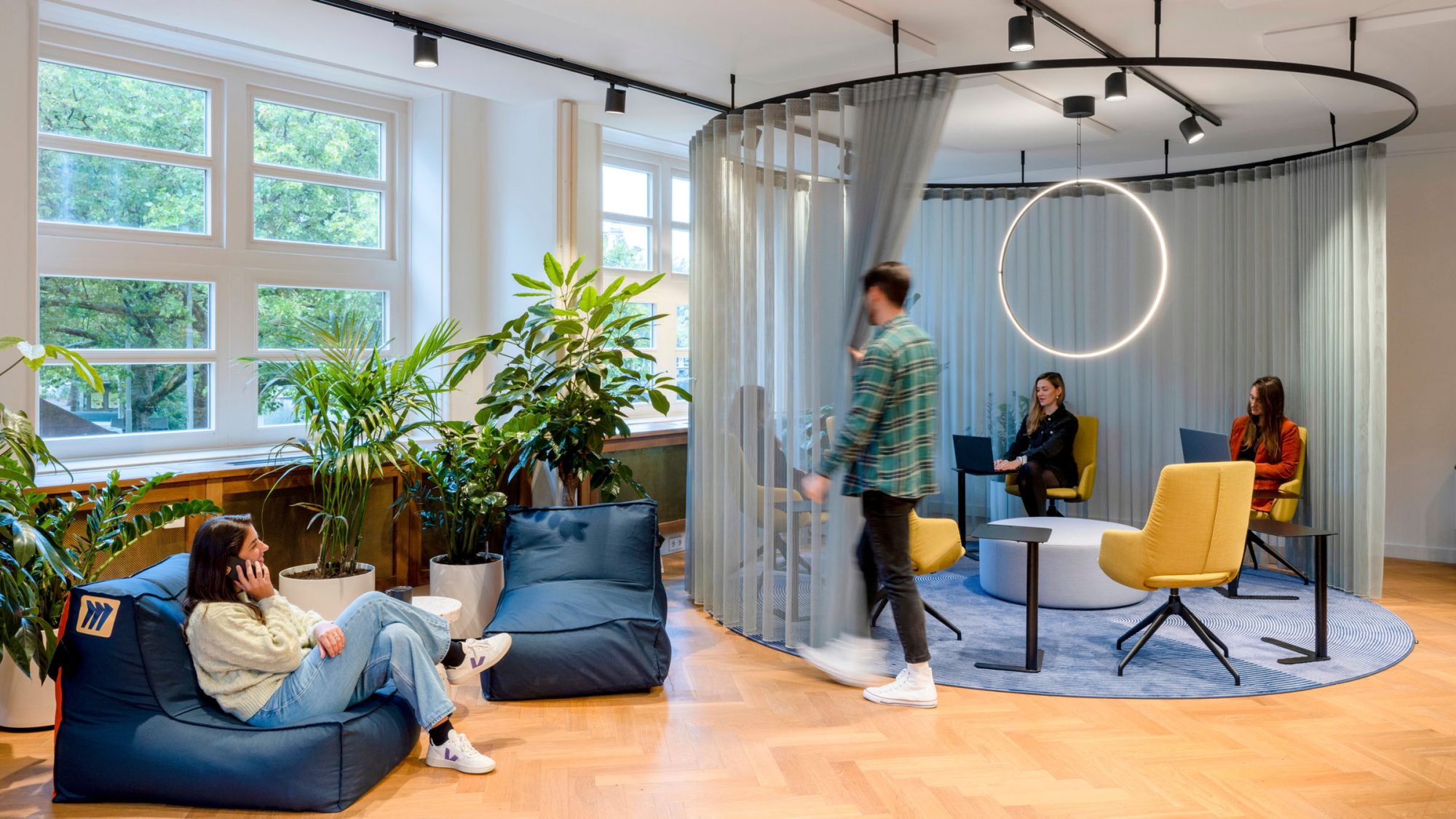The world of work is evolving, and one of the most significant changes in recent years has been the rise of flexible workspaces. Flexible workspaces, which include coworking spaces, shared offices, and remote work hubs, are reshaping how, when, and where professionals engage in their work. These spaces go beyond providing a physical location—they support networking, learning, and a dynamic environment that fosters creativity and growth.
This article will explore the ways in which flexible workspaces drive professional growth and innovation, ultimately creating a productive environment where individuals and businesses can thrive.
Understanding Flexible Workspaces
1. What Are Flexible Workspaces?
Flexible workspaces are office setups that offer a range of options for how and where people work. Unlike traditional offices, flexible workspaces adapt to the needs of the individual or business. These spaces may include hot-desking, where multiple people use the same desk at different times, as well as dedicated desks, private offices, and shared amenities.
These spaces cater to a wide range of professionals, from freelancers and startups to established companies. As work becomes increasingly digital and mobile, the demand for flexible workspaces is on the rise, offering businesses the chance to reduce overhead costs while providing employees with greater autonomy.
2. Types of Flexible Workspaces
Flexible workspaces can vary widely depending on the provider and location. Here are some common types:
- Coworking Spaces: These are shared spaces where individuals from different companies work side-by-side, often with communal areas and event spaces.
- Remote Work Hubs: Designed for remote workers, these hubs allow people to work closer to home while enjoying professional amenities.
- Private Offices within Shared Spaces: These provide a more traditional setup within a flexible workspace environment, with dedicated offices for teams needing privacy.
- Hot Desking and Dedicated Desks: Hot desking allows workers to choose any available desk, while dedicated desks are reserved for specific individuals.
These spaces provide adaptability to meet diverse professional needs, facilitating innovation and efficiency in various ways.
How Flexible Workspaces Promote Professional Growth
1. Fostering a Culture of Learning
Flexible workspaces encourage continuous learning and development, which are crucial for professional growth. Many coworking spaces host workshops, seminars, and networking events that give professionals the chance to learn new skills and gain industry insights. These events may cover topics like digital marketing, entrepreneurship, software development, and leadership, providing a knowledge-rich environment for professionals to expand their expertise.
Additionally, being surrounded by individuals from different fields allows for the exchange of ideas and knowledge, often resulting in organic learning. This constant exposure to diverse perspectives can inspire professionals to explore new methods and gain a broader understanding of their industry, setting the stage for ongoing growth.
2. Networking Opportunities
Networking is a powerful tool for career advancement, and flexible workspaces provide a natural setting for connecting with other professionals. By working in close proximity to others in various fields, professionals have the chance to forge connections that could lead to collaborations, partnerships, or even new job opportunities.
In traditional office settings, networking can be limited to colleagues within the same company. However, in a coworking or shared workspace, professionals can engage with a broader community. Whether through informal conversations in communal areas or structured networking events, flexible workspaces make it easier to meet like-minded individuals and industry experts, expanding one’s professional network.
3. Supporting Work-Life Balance and Wellbeing
Flexible workspaces often incorporate wellness programs and design elements that contribute to a healthy work-life balance. Many offer yoga classes, wellness workshops, and relaxation areas to help professionals recharge and maintain their mental and physical well-being. These amenities create a balanced environment where professionals feel supported, leading to increased job satisfaction and motivation.
The flexibility to choose when and where to work also allows individuals to better manage their personal and professional lives, reducing burnout and improving overall productivity. A healthier, more satisfied workforce is more likely to engage fully in their work, which supports personal growth and professional success.
4. Encouraging Skill Development through Cross-Functional Collaboration
Working alongside professionals from various industries creates opportunities for cross-functional collaboration. For instance, a tech startup founder might collaborate with a marketing expert, or a freelance writer might work with a graphic designer on a project. These cross-functional collaborations allow professionals to gain new skills and perspectives, leading to a richer understanding of their work.
Flexible workspaces enable individuals to step out of their comfort zones and tackle projects they might not encounter in a traditional office setting. This exposure to new ideas and methods encourages skill development, making professionals more adaptable and capable of handling diverse challenges in the future.
How Flexible Workspaces Spark Innovation
1. Creating a Dynamic Environment for Creativity
One of the biggest advantages of flexible workspaces is their ability to stimulate creativity. The layout and design of these spaces are often more vibrant and adaptable than traditional offices, featuring open layouts, colorful decor, and collaborative areas. This creative atmosphere allows professionals to break free from rigid office setups, fostering an environment where ideas flow more freely.
Studies have shown that an inspiring work environment can boost creativity and motivation. In a flexible workspace, the variety of settings—from quiet corners for focused work to open areas for brainstorming—provides professionals with the mental space they need to innovate and think outside the box.
2. Access to Cutting-Edge Technology
Many flexible workspaces invest in high-quality technology, including fast Wi-Fi, video conferencing tools, and digital collaboration platforms. By providing access to the latest tools and technologies, these workspaces ensure that professionals can work efficiently and stay connected.
In some coworking spaces, professionals can also access niche equipment, like 3D printers, photography studios, or advanced software, enabling them to experiment with tools they might not otherwise have access to. This accessibility promotes experimentation and innovation, as professionals are encouraged to use these resources to test ideas, develop projects, and push creative boundaries.
3. Flexible Workspaces Support Startup Ecosystems
Many flexible workspaces are home to startups and entrepreneurs. These environments provide startups with access to valuable resources, mentorship programs, and funding opportunities, creating a thriving ecosystem for innovation. Being surrounded by other startups and ambitious professionals fosters a culture of creativity, experimentation, and growth.
Flexible workspaces designed for startups may also offer accelerator programs, pitch nights, and investment opportunities. Startups benefit from the support network these spaces provide, which can be crucial during their growth phases. By creating a supportive environment for startups, flexible workspaces help drive innovation and make it easier for entrepreneurs to bring their ideas to market.
The Role of Flexibility in Attracting and Retaining Talent
1. Attracting Top Talent with Flexible Work Options
In today’s competitive job market, professionals value flexibility, autonomy, and a supportive work environment. Companies that offer flexible work options, including access to coworking or remote hubs, are more likely to attract top talent. Millennials and Gen Z professionals, in particular, place a high priority on work-life balance and seek out employers who provide flexibility.
Flexible workspaces allow companies to accommodate these preferences by offering a variety of work options, from remote work to hybrid setups. By leveraging flexible workspaces, businesses can create an appealing workplace culture that aligns with the values of today’s workforce, making it easier to attract and retain skilled professionals.
2. Retaining Talent through a Supportive Environment
Employee retention is a key challenge for many companies, especially in highly competitive industries. Flexible workspaces help businesses retain talent by providing an environment that prioritizes employee well-being and productivity. The amenities, collaborative spaces, and networking opportunities found in flexible workspaces contribute to a positive work experience.
Professionals who have access to a supportive, dynamic work environment are more likely to feel engaged and satisfied with their work. By investing in flexible workspaces, companies can reduce turnover, build a loyal workforce, and create a culture that values employee growth and innovation.
Flexible Workspaces and the Future of Work
1. Embracing Remote and Hybrid Work Models
Flexible workspaces are a key component of the shift toward remote and hybrid work models. As businesses continue to adopt these models, the demand for flexible workspaces is expected to grow. Many companies are finding that a hybrid approach—where employees split their time between home, a flexible workspace, and the traditional office—enhances productivity and job satisfaction.
Flexible workspaces offer a solution for companies that want to provide employees with autonomy while maintaining a professional and collaborative environment. As work models evolve, flexible workspaces are poised to play an essential role in shaping the future of work.
2. Adapting to Changing Business Needs
The flexibility of these workspaces allows companies to scale their operations up or down as needed, making them a cost-effective solution for businesses that face fluctuations in staffing or space requirements. This adaptability is especially valuable in today’s fast-changing economic landscape, where businesses must be agile and responsive.
By using flexible workspaces, companies can quickly adjust to changes in the market, enter new locations, or test new ideas without committing to long-term leases or significant overhead costs. This agility positions businesses to respond effectively to emerging trends and evolving business needs.
Conclusion: Flexible Workspaces as Catalysts for Growth and Innovation
Flexible workspaces offer far more than just a place to work—they create an environment that supports learning, collaboration, and creativity. By providing access to resources, networking opportunities, and dynamic spaces, flexible workspaces drive professional growth and encourage innovation. For individuals and companies alike, these spaces are powerful tools for navigating the complexities of the modern work environment and achieving long-term success.
As the future of work continues to unfold, flexible workspaces will remain integral to how professionals grow and innovate, fostering a productive and adaptable workforce equipped to meet the challenges of a globalized, ever-evolving market.


